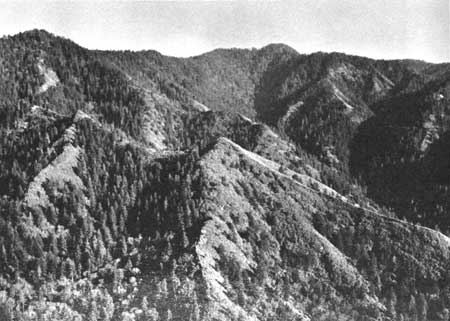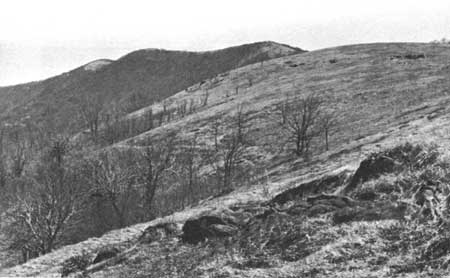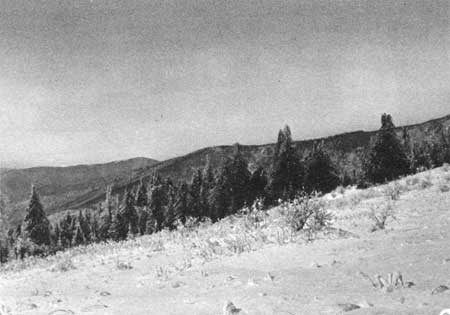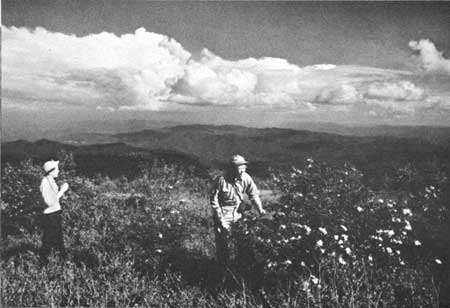|
GREAT SMOKY MOUNTAINS National Park |
 |
Balds
Although there is no true timberline in the southern Appalachians, there are treeless areas on some of the higher mountaintops and ridges. Owing to their lack of forest cover, such places are called balds. That designation, however, is a relative one since other plants form a dense carpet over the balds. If these plants are largely shrubs belonging to the heath family, such balds are known as heath balds; if grasses and sedges prevail, the balds are termed grass balds.
Heath balds are locally referred to as slicks. From a distance they may appear to be smooth, or "slick," but, in reality, they are veritable entanglements which are almost impenetrable. Catawba rhododendron, mountain-laurel, blueberry, and sandmyrtle are the dominant shrubs, and, since all but the blueberry are evergreen, these slicks remain green throughout the year. However, there comes a time, usually in mid-June, when the profusion of spectacular bloom is such that even the greenery is masked out by innumerable flowers. A floral luxuriance pervades all these high-altitude (above 3,500 feet) slicks, and this is the time when rhododendron and laurel festivals are celebrated in neighboring communities. You should then experience the thrill of being in the midst of such a spectacle of floral beauty by hiking to Alum Cave Bluffs, or, a week or so later, to Mount Le Conte or along the Appalachian Trail.
 Heath "balds" consist largely of catawba rhododendron and mountain-laurel. They outline the peaks and ridges in this rugged section of the Smokies near Alum Cave Bluffs. Red spruce, the dominant forest tree on these higher mountainsides, gives way to yellow birch in the intervening valleys (lower left). Courtesy, W. M. Cline Co. |
In a region so completely dominated by forest, how is one to account for the numerous heath balds? Ecological investigations made by Dr. Stanley A. Cain (1930b, "Selected Bibliography") point to three factors: windfall, landslide, and fire. Of these, fire is of greatest importance. Long before man came upon the scene, lightning strikes resulted in fires. Although such catastrophes were of serious consequence to most species of trees, the rhododendrons and mountain-laurel sprouted back readily.
Unlike the heath balds which are practically impenetrable, the grass balds are inviting meadowlands over which you may roam at will. Grasses, sedges, and various other herbs predominate. Being located on, or near, the main crest of the Great Smoky Mountains, all afford places from which outstanding panoramas of the park and vicinity are to be had. Along the margins of some of these clearings, particularly on Gregorys Bald, there are spectacular concentrations of wild azaleas. A number of theories which attempt to explain the origin of the grass balds of the Smokies have been advanced but, as yet, none can be regarded as being entirely satisfactory. In other words, we don't know how these high-mountain grasslands came into being.
 Spence Field Bald, located on the State-line ridge above Cades Cove, is the largest mountain meadow in the park. The question of how these bare areas originated in a region of heavy forest is undecided. |
Once man appeared upon the scene, the modifying effect of his clearing operations and the grazing by his livestock was considerable. A century of cattle- and sheep-grazing must have been an important factor in keeping these meadows in an open condition. Since 1936, when cattle grazed on Gregorys Bald for the last time, there has been a very real invasion of plants from the adjacent forest. Does this mean that the grass balds will disappear? Not in our lifetime. But if future generations should witness the transformation to a forested condition, such a change will be a natural one, unaffected by man—a change in keeping with the National Park Service policy of not interfering with nature's scheme of things.
 Andrews Bald, in the foreground, and snow-covered Silers Bald, on the main ridge in the distance. Some of the early mountain settlers grazed their cattle in these clearings in the summer. |
The finest floral spectacle in the park comes during the last half of June, usually between June 20 and 25, when the wild azaleas on Gregorys Bald come into bloom. As a result of long-continued natural hybridization between the white- and orange-colored forms and their progeny, the flowers are yellowish, buff, shell-pink, salmon, and various shades of red. Domelike Gregorys Bald, located near the western end of the Great Smokies range, rises 3,000 feet above Cades Cove. For those who enjoy hiking, the top of Gregorys Bald, 4,948 feet, should constitute an unrivaled objective if the trip can be made in late June. Best access is via the Gregory Ridge Trail, which begins at the terminus of a spur road in the southwestern corner of Cades Cove. This trail, also called the Big Poplar Trail, passes through a splendid forest of mature yellow-poplars, eastern hemlocks, and other giant trees.
 Wild azaleas bloom on Gregorys Bald in late June. Here, where sheep were once pastured, is one of the finest floral displays in the Smokies. Courtesy, Thompsons Photography, Inc. |

|

|
| NPS History | History & Culture | National Park Service | Contact |
|
Last Modified: Sat, Nov 4 2006 10:00:00 pm PST |


